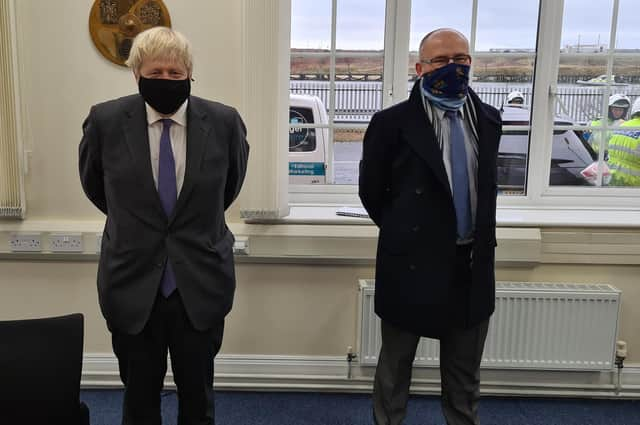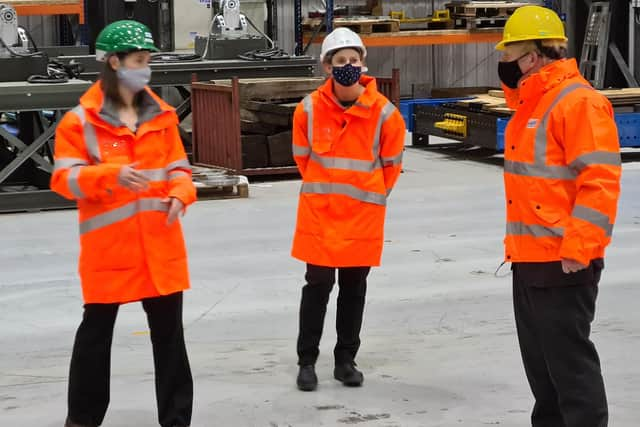Bullish Boris renews commitment to North East - but how is he measuring up on levelling-up?


Boris Johnson visited the constituency which was the first crack in the so-called red wall almost exactly a year to the day since he secured the keys to Number 10 at the General Election.
One of the key thrusts of his premiership since December 2019 has been the levelling-up agenda, with communities that have felt – and still feel – left behind hungry for jobs and investment.
Advertisement
Hide AdAdvertisement
Hide AdHis destination was therefore a success story for Blyth and Northumberland, in an industry which is green, growing and forward-looking, and in a town with a Tory MP (Ian Levy) for the first time to match a Conservative-run county council.


The ORE Catapult site is at the heart of the chosen focus for the town of offshore wind specifically and renewable energy more generally, an obvious place for Mr Johnson to try to remind the electorate of his 10-point plan for a green industrial revolution, announced in November.
RELATED: Boris Johnson hails bright future for North East after Brexit as he jibes 'unreasonable' EU
Fortuitously for him (and definitely a coincidence, as his visit has been in the planning for some time), he arrived in Blyth just as a company operating in another key green industry – electric vehicles – has announced proposals for what could be a transformational investment in the area.
Britishvolt plans to build the UK’s first gigaplant – a huge factory to produce batteries for electric vehicles – bringing with it the possibility of up to 8,000 direct and indirect jobs.
Advertisement
Hide AdAdvertisement
Hide AdYes, work on the Energy Central project was ongoing under the previous Labour-led council and supported by the party’s MPs, but voters are more likely to remember who was there when the actual investment was announced or delivered.
But in an ironic twist, while clearly linked to Blyth and its existing renewables prowess, the actual site – the former Blyth Power Station – is actually in Cambois, lying as it does to the north of the river, and therefore in the Wansbeck constituency of the previous chairman of the Labour Party, Ian Lavery.
Politicians of all colours will claim credit, and be criticised for trying to claim credit for it, but as one online commenter pointed out, given both Mr Levy and Mr Lavery welcome and support the proposal, wouldn’t it be great if they could just work together for the good of the area?
Regardless of its exact location, it fed into the mood Mr Johnson was trying to paint during his visit – one of real optimism for the future of Blyth, the county and the wider region.
Advertisement
Hide AdAdvertisement
Hide AdHowever, this was if not overshadowed then clearly put into some perspective by the looming prospect of a no-deal Brexit, with the North East often highlighted in studies as the region set to be the worst hit.
Brexit was, of course, another of the key issues that decided the election so soundly in the Conservatives’ favour in many previously Labour-held areas.
It would be hard to prove definitively that any one issue was the deciding factor, but Mr Levy himself opened his acceptance speech last December by saying ‘Thank you Boris’, suggesting that Mr Johnson’s core messages – which focused heavily on leaving the EU – were at least as important as any local campaigning.
It goes without saying that Brexiteers may not be as pessimistic about the impact of a no deal as some, but it cannot be denied that there is a nervousness in the North East about any potential threat to jobs or the economy, particularly in this most difficult of years.
Advertisement
Hide AdAdvertisement
Hide AdIt likely comes as no surprise that the Prime Minister remained bullish when pushed on this topic, saying the final deal was not yet certain, that European markets would still be there, and that the EU is just a small part of a wider world which is ‘hungry for British produce’, a particular opportunity for a region which is the country’s top net exporter.
What he didn’t say is that the North East is also the English region with the highest proportion of exports which go to the EU – 60% in 2018.
There was also an interesting juxtaposition in relation to the proposed gigaplant at Blyth being billed as the largest industrial investment in the North East since Nissan came to Wearside in the 1980s.
Because while the Britishvolt announcement is raising hopes of the arrival of jobs in the numbers that would be a once-in-a-generational opportunity for the Blyth area, the bosses of the Japanese car giant have previously warned that its Sunderland plant would not be viable in the event of a no-deal Brexit.
Advertisement
Hide AdAdvertisement
Hide AdThe Prime Minister accepted that Nissan was important and that talks would take place, but he also went on to say that the Government would be looking at the tax and regulatory environment, among other things, to ‘make this the number-one place to invest’. “I think the UK and the North East will be bouncing back next year very strongly indeed,” he added.
When it was pointed out that this is not particularly reassuring for employees who fear for their jobs, he simply replied: “Let’s see where we get to and the terms on which we can trade.”
He then accused ‘our EU friends’ of being ‘more than a little bit unreasonable’, in particular in relation to being locked into their legal framework and on fishing rights.
“I would say to workers across the whole of the North East, this is an area which has an amazing future under any view and the UK Government is going to support it with our uniting and levelling-up agenda, whatever happens,” he said.
Advertisement
Hide AdAdvertisement
Hide AdAnd, of course, there’s the elephant in the room, the Covid-19 pandemic, which has shifted from a mood of ‘we’re all in this together’ during the first phase in the spring to constant comparisons between areas or even individual towns and villages about rates and restrictions.
“I totally understand why people feel so hacked off and so frustrated about what’s been happening with the tiering, that they’ve been put in a region with a high tier when they’re in a neighbourhood where the disease isn’t really rife,” the Prime Minister admitted.
There is nothing to suggest any Government would have handled the situation much differently in terms of the general principles, but it will be interesting to see whether voters’ memories are long enough for those who feel aggrieved to take their displeasure with them to the ballot box in 2024.
Much will likely rely on the roll-out of the vaccine and whether the country can get back to normal next year, but Mr Johnson himself did warn: “The vaccine is not here yet in the numbers we need.”